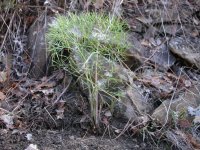Mountain medicament - peucedanum officinalis l.
Family Celery (Apiaceae) - Umbelliferae
Botanical characteristics. Perennial herbaceous plant up to 1 m high. Rhizome thick, brown, from which the thin roots go. Stems erect. The leaves are twice triple-pinnately-divided. Flowers are small white, collected in large multi-flowered umbrellas. All parts of the plant are very fragrant, especially the rhizome, reminiscent of the smell of celery. Fruit is an oval, convex seed. Blooms from June to August. Fruits until the autumn.
Spread. It grows in the chernozem feather-grass steppes, in the mountains, prefers calcareous and siliceous soils, mountain meadows, in thickets of bushes, in the steppes, often forms thickets.
Used parts of the plant. The medicinal raw material is the entire plant, but mostly roots and rhizome. They are collected in early spring or late autumn, dried in dryers in a cut form at a temperature of no higher than 50 ° C.
The aerial part of the plant is harvested during flowering; Seeds - as they mature. Dry in the open air, in the shade. Store in a closed container.
Chemical composition. The roots and the aerial part of the mountain grouse contain essential oils (in large quantities). The roots contain carbohydrates: sucrose; Coumarins: peydedecadanin, bergaptol, peucenol, poucedin, isomerate; pectin. The aerial part contains flavonoids: kaempferol, quercetin, isoramnetin, rutin and their derivatives; Microelements, vitamins, resins, gum.
Application. The roots are the raw material for the preparation of the drug "Pecedanin", used to treat vitiligo, circular alopecia and as an antitumor agent.
Essential oil in the experiment shows virucidal activity against the influenza virus and fungicidal activity against many fungal infections, as well as anti-inflammatory and analgesic in acute respiratory infections.
The root extract in the experiment has antibacterial and fungicidal properties.
In folk medicine, gorichnik in the form of decoctions of roots and above-ground part is used for bronchial asthma both inside and in the form of inhalations; Diseases of the liver, gallbladder, diseases of the gastrointestinal tract, insomnia, as an expectorant; External - in the form of rinses - with diseases of the mouth, toothache; In the form of poultices - with gout, rheumatism, radiculitis.
Fresh juice of the plant is used with bites of poisonous insects, both inside and outwardly.
Young plants and rhizomes are edible.
Preparation
- For the broth take 20 g of roots or aerial parts of the hump mange, pour 200 ml of boiling water, insist on a boiling water bath for 30 minutes, cool 10 minutes, without removing from the bath, filter the warm. Take 1/3 cup 3-4 times daily before meals.
- For infusion of 20-30 grams of leaves and flowers, pour 200 ml of boiling water, insist on a boiling water bath for 15 minutes, cool for 45 minutes, filter. Take should be 1/3 cup 3-4 times a day before meals.
- Tincture from the roots is prepared on 70% alcohol at the rate of (1: 5), insist in a dark place for 10-15 days, filter and take 1 teaspoon 3 times a day before meals.
- Fresh juice can be harvested for future use. Inside take 1 ts.lozhke 3-4 times a day, washing down with water.
- Ready-made preparations are used according to the prescription of the doctor and according to the attached instructions.





Comments
Commenting on, remember that the content and tone of your message can hurt the feelings of real people, show respect and tolerance to your interlocutors even if you do not share their opinion, your behavior in the conditions of freedom of expression and anonymity provided by the Internet, changes Not only virtual, but also the real world. All comments are hidden from the index, spam is controlled.